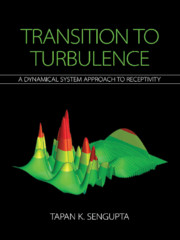Book contents
- Frontmatter
- Dedication
- Contents
- Preface
- 1 Receptivity, Instability, and Transition: A Perspective
- 2 Dynamical System Theory and Role of Equilibrium Flows
- 3 Fundamentals of Scientific Computing
- 4 Instability and Transition
- 5 Receptivity Analysis: Relation with Instability Experiments
- 6 Dynamical System Theory of Linear Receptivity
- 7 Nonlinear, Nonparallel Effects on Receptivity, Instability, and Transition
- 8 Three-Dimensional Routes of Transition to Turbulence
- 9 Receptivity to Free Stream Excitation: Theory, Computations, and Experiments
- 10 Nonlinear Receptivity Theories: Hopf Bifurcations and Proper Orthogonal Decomposition for Instability Studies
- 11 Mixed Convection Flow
- 12 Baroclinic Instability: Rayleigh–Taylor Instability
- 13 Coherent Structure Tracking in Transitional and Turbulent Flows
- 14 The Route of Transition to Turbulence: Solution of Global Nonlinear Navier–Stokes Equation
- References
12 - Baroclinic Instability: Rayleigh–Taylor Instability
Published online by Cambridge University Press: 16 February 2021
- Frontmatter
- Dedication
- Contents
- Preface
- 1 Receptivity, Instability, and Transition: A Perspective
- 2 Dynamical System Theory and Role of Equilibrium Flows
- 3 Fundamentals of Scientific Computing
- 4 Instability and Transition
- 5 Receptivity Analysis: Relation with Instability Experiments
- 6 Dynamical System Theory of Linear Receptivity
- 7 Nonlinear, Nonparallel Effects on Receptivity, Instability, and Transition
- 8 Three-Dimensional Routes of Transition to Turbulence
- 9 Receptivity to Free Stream Excitation: Theory, Computations, and Experiments
- 10 Nonlinear Receptivity Theories: Hopf Bifurcations and Proper Orthogonal Decomposition for Instability Studies
- 11 Mixed Convection Flow
- 12 Baroclinic Instability: Rayleigh–Taylor Instability
- 13 Coherent Structure Tracking in Transitional and Turbulent Flows
- 14 The Route of Transition to Turbulence: Solution of Global Nonlinear Navier–Stokes Equation
- References
Summary
Baroclinic Instability
Baroclinic instability of flow is of interest in multiple branches of engineering, geophysics and astrophysics. It is considered very important in explaining motion in earth's atmosphere and in the ocean. Rayleigh–Taylor instability is an example of a baroclinic instability introduced in Chapter 1, as a special case of the inviscid Kelvin– Helmholtz instability. Rayleigh–Taylor instability, in its simple connotation, arises when a heavier fluid is made to rest on top of a lighter one, as the initial equilibrium state. If the heavier and lighter fluids are perfectly aligned with the direction of gravity, then such an equilibrium state would remain stable. If an instability misaligns this configuration, then the ensuing turning moment will unabatedly destabilize the initial state. However, if the opposite initial configuration of a lighter fluid resting on top of heavier fluid is perturbed, then the turning moment will restore the equilibrium state.
This qualitative explanation of Rayleigh–Taylor instability can be given more meaning, physically and mathematically, by considering the Euler equation for a compressible flow. Taking the curl of the momentum conservation equation in its primitive variable form, one can depict the corresponding inviscid vorticity transport equation as
where and are the velocity and vorticity vectors, and the last term on the right-hand side is the baroclinic contribution to vorticity generation by the misalignment of the pressure gradient from the density gradient. Thus, for baroclinic flows, pressure is not dependent on density alone, but also depends on the temperature. In contrast, an atmospheric flow is called barotropic, for which the pressure depends only on density, and thus, the cross product is identically zero. It should also be noted that the term, is due to compressibility and prediction of such instabilities should justifiably depend upon bulk viscosity for the constitutive relation between stress and rates of strain tensors.
In atmospheric motion, baroclinic instability is the main source for the formation of cyclones and anti-cyclones, occurring mainly in temperate latitudes. At the tropics, the atmospheric flow is barotropic. The baroclinic instability is observed to contribute to the formation of eddies in the mesoscale. However, such instabilities are for a rapidly rotating fluid, which also displays strong density stratification. The nondimensional parameter, Richardson number, is an indicator of the strength of stratification, with large values indicative of stable stratification.
- Type
- Chapter
- Information
- Transition to TurbulenceA Dynamical System Approach to Receptivity, pp. 459 - 496Publisher: Cambridge University PressPrint publication year: 2021



